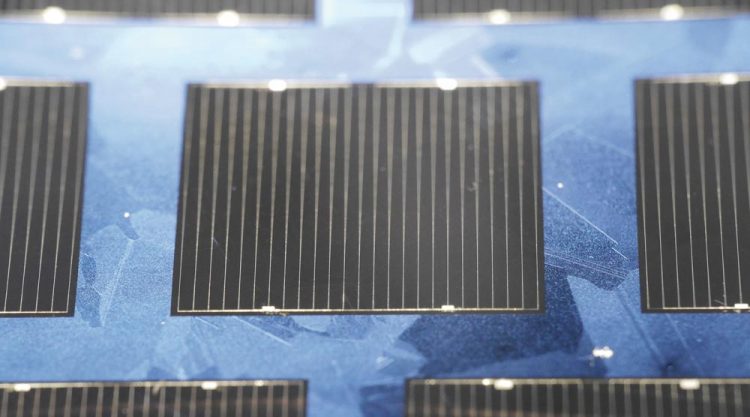Fraunhofer ISE Pushes World Record for Multicrystalline Silicon Solar Cells to 22.3 Percent

Photo of the world record multicrystalline silicon solar cell with 22.3 percent efficiency. Fraunhofer ISE
Multicrystalline silicon, the work horse of the photovoltaic industry, dominates the PV module production worldwide with a market share of 57 percent. In the last few years, the efficiencies of the more expensive monocrystalline solar cells have increased greatly, thus widening the gap between mono and multicrystalline material.
At Fraunhofer ISE in Freiburg, the researchers have succeeded in decreasing this efficiency gap by surpassing their own world record efficiency for multicrystalline solar cells which they established just a few months ago. Pushing beyond the magical threshold of 22 percent, their newest solar cell converts 22.3 percent of the incident solar energy into electricity. The researchers affirm that the maximum potential of the material and the cell technology has not yet been realized.
The new record became possible through the use of highly pure silicon supplied by the project partner Wacker and also through adjustments that targeted the needs of the multicrystalline material in both the crystallization and the cell processing steps.
An optimized plasma texture and a so-called “Tunnel Oxide Passivated Contact Technology (TOPCon),” developed at Fraunhofer ISE for back side contacting played an essential role. With the TOPCon technology the electrical contacts are applied over the entire rear surface of the cell without patterning. This reduces charge-carrier losses and leads to much higher electrical efficiencies.
“We are pleased to have succeeded in achieving such an excellent result,” remarks Martin Hermle, Department Head of Advanced Development of High-Efficiency Silicon Solar Cells at Fraunhofer ISE. Hermle adds: “The key to our success was the holistic approach which enabled us to optimize all steps, from the crystallization up to the individual solar cell fabrication processes. The close and continual cooperation between the characterization, crystallization and the solar cell technology research teams at ISE allowed us to reduce the loss mechanisms step by step and successfully develop an optimized process chain.”
Division Director Prof. Stefan Glunz adds: “These successful results achieved in solar cell efficiency are based on steady, continuous development and demonstrate the strength of European research and innovation in this field. At the same time these advances lead the way for Europe’s entry into market production of the next generation technology on the global scale.”
This record was a achieved within the project “multiTOP“ which runs until March 2017 and is financed by the German Federal Ministry for Economic Affairs and Energy BMWi.
The new world record solar cell will be presented at the European Photovoltaic Solar Energy Conference (EUPVSEC) on September 28, 2017 in Amsterdam by Dr. Jan Benick in his talk “Approaching 22% Efficiency with Multicrystalline n-Type Silicon Solar Cells.”
https://www.ise.fraunhofer.de/en/press-media/press-releases/2017/fraunhofer-ise-…
Media Contact
All latest news from the category: Power and Electrical Engineering
This topic covers issues related to energy generation, conversion, transportation and consumption and how the industry is addressing the challenge of energy efficiency in general.
innovations-report provides in-depth and informative reports and articles on subjects ranging from wind energy, fuel cell technology, solar energy, geothermal energy, petroleum, gas, nuclear engineering, alternative energy and energy efficiency to fusion, hydrogen and superconductor technologies.
Newest articles

NASA: Mystery of life’s handedness deepens
The mystery of why life uses molecules with specific orientations has deepened with a NASA-funded discovery that RNA — a key molecule thought to have potentially held the instructions for…

What are the effects of historic lithium mining on water quality?
Study reveals low levels of common contaminants but high levels of other elements in waters associated with an abandoned lithium mine. Lithium ore and mining waste from a historic lithium…

Quantum-inspired design boosts efficiency of heat-to-electricity conversion
Rice engineers take unconventional route to improving thermophotovoltaic systems. Researchers at Rice University have found a new way to improve a key element of thermophotovoltaic (TPV) systems, which convert heat…



